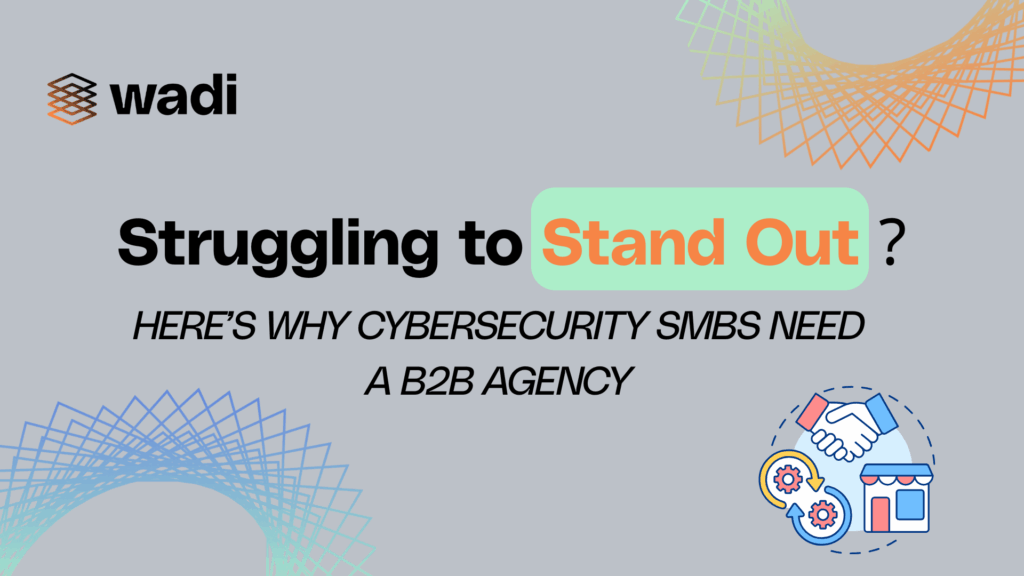Table of Contents
ToggleIn the modern digital age, cybersecurity is more important than ever. As technology continues to advance, so too the threats that businesses and individuals face online. Therefore, cybersecurity companies must be able to adapt to the changing landscape and implement effective cybersecurity marketing strategies to reach their target audience.
Cybersecurity Marketing Landscape
To navigate the marketing landscape and position itself as a trusted provider, a cybersecurity company should leverage an effective digital cybersecurity marketing strategy. Marketing for cybersecurity companies, however, is not without its challenges.
Current Challenges in Cybersecurity Marketing
Some of the most relevant challenges include:
- Trying to be everything to everyone. It involves adopting a universal approach by a cybersecurity company without focusing on fundamental aspects (e.g., identifying primary buyers, understanding their security concerns, recognizing prevalent security threats, etc.);
- Not leveraging customer testimonials. While customer case studies and testimonials are powerful tools for selling cybersecurity solutions, not all cybersecurity companies are willing to go on record;
- Content fails to be the king. It is often a challenge for cybersecurity companies to provide practical tips and recommendations on how their cybersecurity software might assist and protect a private entity or corporate data against fraud;
- Not engaging with influencers. By not following security professionals on social media platforms, cybersecurity companies fail to keep up with the latest trends, keywords, and top trending topics in the industry.
The Role of Digital Marketing in Cybersecurity
Effective marketing strategies help cybersecurity companies build their brand and establish a strong presence in the industry. With the evolving cyber-threat landscape, targeted marketing becomes essential to reach the right audience and attract potential customers. Cybersecurity companies can leverage digital marketing techniques such as growth marketing and conversion optimization to optimize their customer acquisition process.
By utilizing digital channels, they can effectively promote their cybersecurity solutions and raise awareness about the importance of protecting private entities and corporate data against cybersecurity threats. Digital marketing allows these companies to engage with influencers in the industry, and stay updated with the latest trends and keywords.
Marketing Strategies for Cybersecurity Companies
Effective marketing strategies help companies establish themselves as trusted industry thought leaders and build strong brand awareness. The key marketing strategies for cybersecurity companies include:
Content Marketing for Cybersecurity
Content marketing helps cybersecurity companies communicate their solutions and stand out in the cyber threat landscape. Here are some practical content marketing strategies for cybersecurity companies:
- Tailor your content to different personas and focus on the key benefits and ROI that matter to your target audience;
- Create content that addresses relevant trends and positions your company as a thought leader;
- Highlight success stories, case studies, and use cases that demonstrate the value of your cybersecurity solution. These assets can be particularly impactful in the later stages of the buyer’s journey;
- Include content on regulations, privacy, and ethics in your messaging and content marketing. Educate your audience on regulations and industry best practices, and highlight how your solution follows privacy laws and protects important data. Discuss vulnerabilities and potential issues, and explain how your solution addresses them.
Social Media Marketing
What is the value of social media marketing for cybersecurity companies? – you may wonder. Around 4.48 billion people worldwide use social media platforms daily. As a cybersecurity company preventing data breaches and protecting privacy, you should use this opportunity to advertise your solutions and grow your following.
Among the leading platforms for cybersecurity marketing is LinkedIn. To leverage it for your B2B marketing efforts, consider the following:
- Create a company page showcasing your solutions, expertise, and thought leadership. Use relevant keywords in the company description to improve search visibility;
- Join relevant LinkedIn groups of your target audience and engage in discussions to share valuable insights and establish yourself as a trusted industry resource;
- Use LinkedIn Ads to target specific job titles, industries, or companies relevant to your solutions and generate leads;
- Attend cybersecurity conferences, contribute to industry publications, and collaborate with influential professionals to enhance industry insights and relationships.

Cybersecurity Marketing Trends in 2024
Here are the top cybersecurity marketing trends that will shape the industry in 2024:
Trend 1: Video Marketing for Engagement
With 40% higher engagement than traditional content, videos offer a versatile and impactful strategy, ensuring impactful message delivery in a cyber-threat landscape. They surpass written content in ease of sharing, constituting over 80% of global Internet traffic. The most effective video types include:
- Explainer videos;
- Animated videos;
- Live-action videos;
- Video testimonials.
With more businesses favoring video marketing for high ROI, its inclusion in the cybersecurity content marketing framework becomes imperative for those looking to enhance client digital assets and market reach.
Trend 2: Influencer Marketing in Cybersecurity
Collaboration with influencers is crucial to emphasizing authenticity and genuine expertise in the field. Educational collaborations (e.g., webinars and joint blog posts) offer a mutually beneficial avenue to showcase cybersecurity trends, while authentic endorsements foster trust within the cybersecurity audience.
The blog underscores the significance of aligning with thought leaders in cybersecurity and positioning your brand as cutting-edge. Trust concerns here are addressed through transparent communication about influencer partnerships, safeguarding hard-earned credibility.
Trend 3: Interactive Content Strategies
Integrating interactive content fosters audience interaction and allows you to gather valuable insights. This approach transforms traditional marketing into inspiring experiences, aligning with the preferences of modern audiences. Interactive elements like surveys, polls, games, and breakout sessions captivate attention and provide opportunities to deepen understanding and relationships with the audience, making digital experiences more immersive and impactful.
The marketing landscape for cybersecurity companies in 2024 is expected to be competitive. By implementing the right cybersecurity marketing strategy, you will be able to leverage the latest trends to stay ahead of the curve and attract more customers for your cybersecurity solutions.






